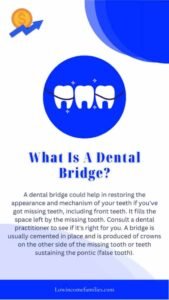A dental bridge is a permanent appliance that replaces missing teeth. It consists of several pieces that are fused to fit your teeth or the empty spaces where your teeth are.
Dental bridges are an alternative to partial dentures. It serves aesthetic purposes and makes it easier to eat and talk. When replacing front teeth, porcelain is usually chosen. This is because they can match the color of your natural teeth.
What Is A Dental Bridge?
A dental bridge could help in restoring the appearance and mechanism of your teeth if you’ve got missing teeth, including your front teeth. It fills the space left by the missing tooth.
Consult a dental practitioner to see if it’s right for you. A bridge is usually cemented in place and is produced of crowns on the other side of the missing tooth or teeth sustaining the pontic (false tooth).

Whether you have a missing tooth or teeth, dental bridges can help. Tooth decay, gum disease, and injury are the three frequent causes of missing teeth.
You might have also been born with missing teeth as a result of a congenital condition. A dental bridge requires healthy teeth on each side of the missing teeth.
When Do You Need A Dental Bridge?
Dental bridges are useful in a variety of situations involving missing teeth. You must close the gap if your tooth must be extracted due to decay, lost due to an injury or accident, or damaged due to periodontal disease.
Leaving a hole in the mouth can cause remaining teeth and bone to shift dramatically. Missing teeth can even alter the shape of your face over time.
Implants are generally regarded as the best option for tooth replacement, but they can be costly. For young mouths that are still growing and changing, dental bridges are a good second option, and some types may be preferred over implants.
The dental bridge is a treatment option that can only be used when healthy teeth are adjacent to the gap. Read on for types of bridges and when you might need them.
Type Of Dental Bridges
Dental bridges are made up of four basic materials. Your dentist may recommend a specific type of treatment to fit your specific case, depending upon the number of teeth and the number of teeth that can be replaced.
Typically a tooth bridge uses adjacent teeth to anchor prostheses. It is possible to fix or bond bridges to existing teeth by fixing them together or by putting in another bridge.
Read More: How much veneers cost with insurance?
-
Implant-Supported Bridges
Unlike crown or bonding, bridges are attached to implants with implants. Dental implants are posts that are tightly inserted into the jawbone to fix the missing 8 in the tooth. This is designed for blending with other teeth. The implants-supported bridge is another more cost-efficient.
These generally require surgical placement of implants, a few weeks or months of medical treatment as well as training of the dental staff to perform the procedure successfully. Some dental bridges require multiple teeth replacements to support a single implant.
-
Dental Bridges
Dental bridges traditionally used as dental appliances for decades are reliable and durable. This dental bridge consists of a false tooth (pontics) which is fixed and attached to each side of the gap.
Immediately upon attachment of the abutment into adjacent teeth, the pontic fills the gaps providing a solid surface that will support chewing. The downside of a traditional fixed bridge is the need for crowns in its abutment tooth. These teeth may not have a decaying condition. The crowning of these pillars ensured stability in this bridge.
-
Maryland Bridges
Maryland’s bridges offer less intrusion. Stainless steel support for false teeth. A framework attaches to an adjacent bone. Your dentist doesn’t need to crown the adjacent tooth like traditional cantilever bridges.
Bridges from Maryland have come uncemented and don’t perform properly in areas whose food is being pulled heavily by molar areas.
Sometimes patients can find it hard for the bars/structures to stay attached to their teeth
-
Bonded Bridge
If you need a tooth replaced, your dental professional might put up a resin-bonded bridge referred to as a Maryland bridge.
Instead of having crowning on an adjacent bone, this bridge is made of metals and porcelain wings on each side which is secured on the outer edge of the adjacent bone. Bonded bridges are essentially designed to retain nearby healthy teeth. The biggest downside is not as strong as a fixed bridge.
The adhesive that holds them together slowly weakens and causes the bridge to collapse and lose. When replacing bridges for teeth, the crowns of the teeth are removed.
-
Fixed Bridges
Fixed bridges are commonly used dental bridges as they offer an easy and durable way to replace adjacent teeth. The bridge prosthesis is mainly constructed with a crown and pontics (artificial teeth) in the middle. The crowns are thin and attach to the adjacent teeth to support a bridge.
The anchor teeth are filed down to a lower size in the tooth bridge to allow proper crowning. This tooth needs to support the girth of bridges.
-
Front Teeth Bridge
A tooth bridge can have at least two crowns on both sides as the bite on incisors is very high. When a front tooth needs removing your tooth your dental professional can recommend the perfect bridge for it.
Cost Of Dental Bridge
How much does it cost to replace teeth with a Dental Bridge? It will depend on the type of dental bridge you require, the materials you choose to use, the number of teeth you need to replace, your insurance coverage, and where you choose to receive your dental care—there are numerous factors to consider.
The price of a dental bridge varies depending on the teeth involved and the number of gaps that must be filled. However, relying on your area along with the metal you choose, you can prepare to pay between $945 and $1367 per tooth.
Dental Bridge Cost Factors Include
Your bridge cost will vary if you choose a material or a bridge. You’ll have to pay the dentist’s fees for performing a consultation, fit, etc. Your local health clinic should probably give you the cost of the consultation before the appointment. Keep in mind that three-unit bridges cost more than a single-unit bridge compared to a single tooth.
You may have a dental expert looking at if there are teeth in your mouth. If you have dental plans, there could also be discounts for restorative care using bridges.
Dental Bridge Materials
The teeth bridge is available in countless material choices as well as the finishing. I’ll show you some of the benefits and disadvantages.
-
Ceramic Only
Porcelain or zircone-like bridges look identical to natural teeth. It is therefore a preferred material in tooth restorations. But the materials and laboratory work are far more costly.
Dental technologies can be used in dental bridge construction. In its early stages, ceramic bridges had poor durability. However, with the advent of dentistry’s modern materials, they become much stronger, allowing Emax crowns for popular use.
-
Porcelain Fused To Metal (PFM)
An economical way to balance costs with appearance is with a porcelain bridge molded into ceramic or porcelain. It can lose its appearance with time when ceramic is exposed to the metal beneath. Similarly, PBMs can not be as robust and stable as pure porcelain. The most suitable dental restoration material depends upon budget and the place in which a missing tooth is placed.
-
Metal Only
Aluminum alloying has the obvious disadvantage that it doesn’t appear like teeth. When the retainer is not visible when smiling, a steel bridge may be an excellent idea.
How To Reduce The Dental Cost Of Bridges
You may have noticed that bridges are less expensive than other cosmetic dentistry procedures.
However, you may not always have the necessary funds. Here are some methods for lowering the cost of dental bridges. Acrylic bridges (plastic bridges similar to dentures) are a low-cost alternative.
Consider a dental plan, which, unlike many health plans, does not require a waiting period. If not, you can wait a while and collect your bridge money during that time.
Dental Bridge Alternatives
There are several options for replacing missing teeth. It is critical to investigate all options and consult with your dentist.
Bridge Alternatives Include:
Dentures (False Teeth) – Full Or Partial
Dentures also referred to as false teeth, are a kind of artificial teeth for individuals who are missing one or more teeth. Able to fit a denture to substitute missing teeth typically improves patients’ eating and speech.
Implants For Teeth
A dental implant is a strong post that is embedded into the jawbone in the area where a tooth is missing. They are made to look like your other teeth.
The most expensive are implant-supported bridges. They usually necessitate surgery to place the implant, weeks or even months of healing time, and specialized training by the dentist and their staff to perform the treatments.
A dental bridge that replaces more than one tooth may necessitate the use of several implants. Implant-supported bridges are ideal for patients who are missing three or more teeth in a row.
A crown is an imitation porcelain tooth that is fitted on top of a titanium implant that is anchored directly into your jawbone.
Your dentist will assist you in determining which option is best for you. Dentures and bridges are only provided on the NHS if they are deemed clinically necessary to replace teeth, whereas dental implants are typically only available privately.
How Are Dental Bridges Used?
To create a bridge, the dentist takes a mold from your mouth. This involves making a plaster model of your teeth and gums get the bridge as close to your mouth as possible. At this stage, the dentist will also determine the correct shade of the bridge to match your natural teeth.
The bridge is custom-made by a professional laboratory technician according to the dentist’s instructions. While waiting for a custom bridge to be fabricated, dentists can place temporary solutions such as acrylic bridges and crowns.
When everything is ready, the dentist will adjust the new bridge. Before the procedure begins, you will be given an injection of a local anesthetic to block the pain from your gums, but you will remain awake during the procedure. Your dentist will check that you are chewing properly with the bridge on to ensure a comfortable fit.
Will Insurance Be Beneficial?
With insurance, you will pay significantly less for a dental bridge. However, it is critical to understand your provider’s policies, as they vary greatly between providers.
It aids in pre-existing condition exclusions (such as periodontal disease).
The former may disqualify you from receiving insurance coverage for dental bridges, whereas the latter will require you to wait at least one year before receiving coverage for any procedures other than preventative care.
Dental insurance typically covers 40% to 50% of the total cost of dental bridges. Of course, the percentage of people covered varies by provider and location. However, this is the most common range provided by insurance companies.
Conclusion :-
Although there are benefits and drawbacks to getting a dental bridge, research has revealed that with brushing and flossing and dental health visits, a dental bridge can be a long-term solution to missing teeth.
Nevertheless, every scenario and individual is distinctive, and several factors influence who is a good choice for them. Discuss your options with your dentist to determine whether you should get a dental bridge and, if so, which type is best for you.
Frequently Asked Questions
Is It Worth It To Get A Dental Bridge?
The bridge is cheaper than implants. Dental bridges are more accurate and less painful in construction. Therefore, it costs less than dental implants. Some patients opt to have bridges rather than implants. There is no graft procedure.
How many teeth can be on a bridge?
Dental Bridge services can be used to replace one to four teeth, depending on what you need. Typically though the teeth are replaced by a few. In rare situations though, you can still have four teeth in an oral bridge
What is the cheapest way to replace a missing tooth?
Denture Treatment. Dentures can be a cheaper alternative for tooth replacement solutions. Because it requires less time for them to create. It requires no surgical procedure and the tooth crown must be removed.
Is a partial cheaper than a bridge?
A partial denture is typically cheaper than a bridge. The cost to replace your teeth depends on what your prosthetic was created from.












